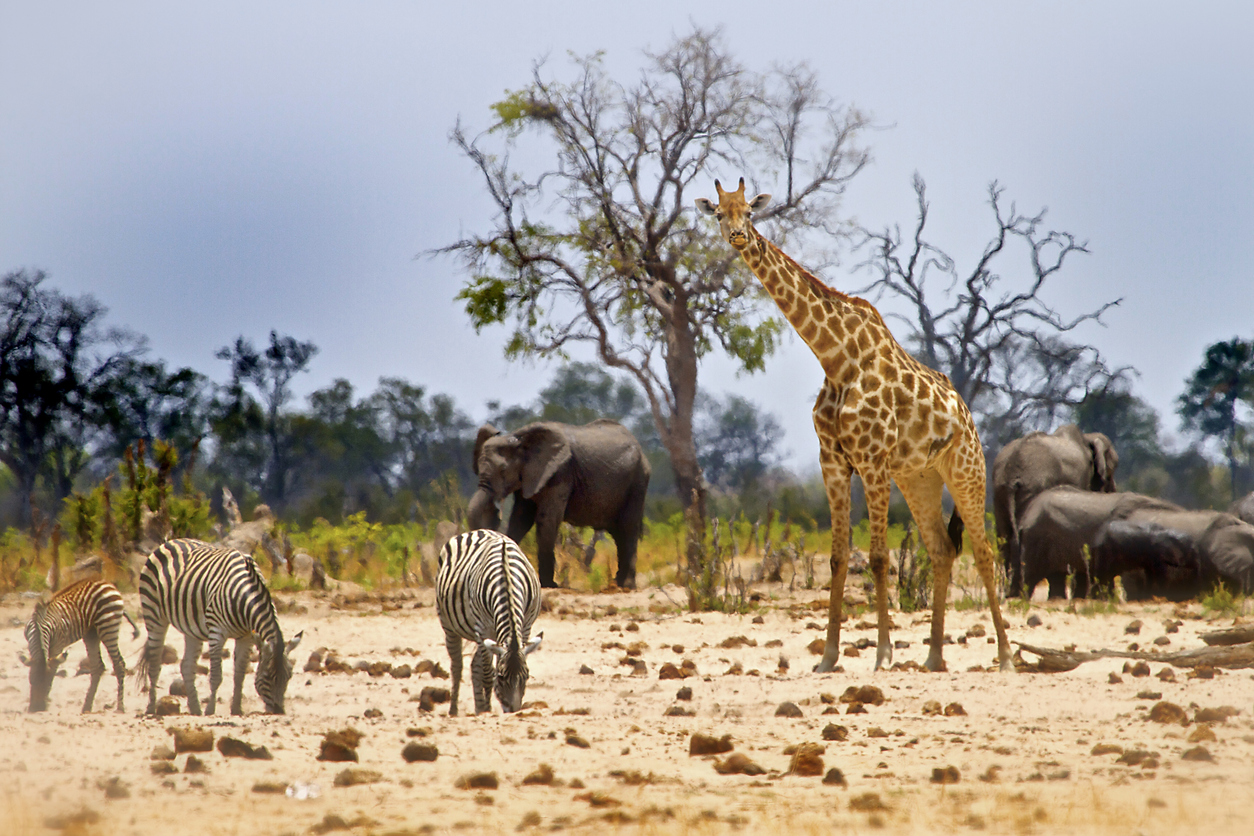Matusadona National Park, nestled along the shores of Lake Kariba in Zimbabwe, stands as a testament to the splendour of nature.
Renowned for its scenic beauty and diverse wildlife, this national park offers a captivating experience for nature enthusiasts and wildlife aficionados.
ALSO READ: https://zimprofiles.com/nyanga-trout-hatchery-a-unique-experience-for-fishing-enthusiasts/

Matusadona National Park: Picture credit to Robin Pope Safaris
Origin of the Name
The name “Matusadona” has its roots in the local Tonga language, meaning “falling dung.”
The park’s name reflects the presence of large herds of elephants that inhabit the area, contributing to its ecological significance.
The name “matusadonha” has an interesting and possibly surprising origin! It comes from the Shona word “matuzviadonha”, which translates to “falling dung” or “the dung has fallen”.
Here’s the story:
- The name refers to the Matuzviadonha Hills, which are prominent features within Matusadona National Park in Zimbabwe.
- Elephants are common in the area, and they leave plenty of dung behind while traversing the steep slopes of the hills.
- The local people likely observed this phenomenon and used it to name the hills, reflecting the abundance of elephants and their influence on the landscape.
- Over time, the name “matuzviadonha” was adapted by colonial settlers into “matusadona”, possibly due to mispronunciation or simplification.
So, while the name might sound unusual at first, it paints a vivid picture of the park’s environment and its history with elephants.
Here are some resources where you can learn more:
- Matusadona National Park website: https://www.africanparks.org/the-parks/matusadona/contact
- Victoria Falls Guide: https://www.victoriafalls-guide.net/
- Africa Geographic: https://en.wikipedia.org/wiki/Matusadona_National_Park
History of the Place
Steeped in a rich history of conservation efforts, Matusadona National Park has evolved into a protected wilderness area.
Established to safeguard the flora and fauna surrounding Lake Kariba, the park’s history is intertwined with the preservation of its natural beauty and ecological balance.
History of Matusadona National Park: A journey through wildlife and conservation
ALSO READ: https://zimprofiles.com/from-chiefs-to-campers-unveiling-the-legacy-of-lake-mutirikwi/
Matusadona National Park: picture credit to Changa Safari
Matusadona National Park boasts a rich and intriguing history, intertwined with wildlife conservation and human impact. Here’s a glimpse into its journey:
Early days (Pre-1958):
- The area belonged to the indigenous people, known as the BaTonga, who lived in harmony with the diverse wildlife for centuries.
- Hunting activities existed but were primarily focused on subsistence, not large-scale exploitation.
Transformation and challenges (1958-1975):
- 1958: Declared a non-hunting area, recognizing the ecological value.
- 1963: Upgraded to a Game Reserve to manage wildlife populations.
- 1963-1964: Construction of the Kariba Dam flooded large swathes of the region, displacing wildlife and altering the ecosystem.
- Operation Noah (1958-1963): A remarkable effort led by Rupert Fothergill to rescue thousands of animals stranded by the rising lake waters, relocating them to Matusadona, establishing it as a wildlife haven.
- 1975: Officially declared a National Park under the Parks & Wildlife Act of Rhodesia.
Conservation struggles and decline (1975-2004):
- Early years witnessed thriving wildlife populations, particularly elephants and black rhinos, attracting tourism.
- However, political instability and mismanagement took their toll. Poaching, habitat degradation, and resource overexploitation severely impacted wildlife numbers.
- The lion population, previously abundant, dwindled drastically due to loss of prey habitat.
Renewed hope and restoration (2004-present):
- 2004: African Parks, a non-profit conservation organization, took over management, initiating intensive conservation efforts.
- Anti-poaching measures, community engagement, and habitat restoration programs showed positive results.
- Wildlife populations started recovering, offering hope for the park’s future.
- Tourism is gradually returning, offering sustainable income and contributing to conservation efforts.
Key features of Matusadona’s history:
- Operation Noah: A remarkable conservation success story demonstrating human intervention in ecological balance.
- Impact of human actions: Highlights the fragility of ecosystems and the need for sustainable management.
- Current efforts: Showcase the power of collaboration and dedication in restoring biodiversity and securing a future for the park.
Looking ahead:
Matusadona’s history showcases the challenges and triumphs of conservation.
Continued efforts focused on wildlife protection, habitat restoration, and community involvement are crucial for its long-term success.
By learning from the past and embracing sustainable practices, the park can continue to be a haven for diverse wildlife and a source of pride for Zimbabwe.
Geographical Location
ALSO READ: https://zimprofiles.com/discovering-mavuradonha-wilderness-area-zimbabwes-pristine-haven/

Matusadona National Park: Picture credit to Zimprofiles
Situated on the shores of Lake Kariba, Matusadona National Park unfolds against the backdrop of this massive artificial reservoir.
The park’s strategic location provides breathtaking views of the lake and the surrounding landscapes, contributing to its allure.
Matusadona National Park sprawls across the southern shores of Lake Kariba in northern Zimbabwe, nestled within the Kariba District of the Mashonaland West Province. Its vast plains and rugged mountains encompass an area of approximately 1,400 square kilometres, offering a diverse landscape and a haven for various wildlife species.
Here’s a closer look at Matusadona’s geographical location:
Latitude and longitude: -16.8333° S, 28.6667° E
Country: Zimbabwe
Province: Mashonaland West
District: Kariba
Bordering features:
- North: Lake Kariba
- East: Sanyati Gorge
- West: Ume River
- South: Matusadona Hills and Zambezi Escarpment
Key geographical features:
- Lake Kariba: The world’s largest man-made lake by volume forms the northern boundary of the park, influencing its ecosystem and offering incredible biodiversity.
- Matusadona Hills: These rolling hills, which inspired the park’s name, add a dramatic touch to the landscape and provide habitat for various animals.
- Sanyati Gorge: This deep gorge carved by the Sanyati River creates a stunning natural barrier and diverse terrain within the park.
- Ume River: This perennial river meanders through the western part of the park, providing a vital water source for wildlife and contributing to the lush vegetation.
- Zambezi Escarpment: The southern boundary of the park borders the iconic Zambezi Escarpment, offering breathtaking views and contributing to the overall ecological diversity.
Matusadona’s unique geographical location, encompassing diverse landscapes and bordering significant features, shapes its rich biodiversity and creates a captivating wilderness experience for visitors.
Activities to Do
Here are some activities you can do at Matusadona National Park:
Wildlife viewing: Matusadona National Park is home to a wide variety of wildlife, including elephants, lions, leopards, cheetahs, zebras, giraffes, hippos, crocodiles, and over 400 species of birds. You can go on game drives, guided walks, or boat safaris to see these animals in their natural habitat.
Fishing: Lake Kariba is a world-renowned fishing destination, and you can try your hand at catching tigerfish, bream, and catfish.
Birding: Matusadona National Park is a paradise for birdwatchers, with over 400 species of birds to be found. Some of the birds you might see include the African fish eagle, the martial eagle, the kori bustard, and the saddle-billed stork.
Canoeing: Explore the Sanyati Gorge by canoe and see the wildlife from a different perspective.
Cultural experiences: Learn about the culture of the BaTonga people, who have lived in the area for centuries. You can visit their villages and learn about their traditional way of life.
Relaxing: Simply relax and enjoy the quiet of the park. Take a swim in the lake, read a book in a hammock, or just sit back and enjoy the views.
References
- Zimbabwe Parks and Wildlife Management Authority: Matusadona National Park – Zimbabwe Parks and Wildlife Management Authority, Date Published: [Insert Date]
- Lake Kariba Tourism Guide: Exploring Matusadona’s Wilderness – Lake Kariba Tourism Guide, Date Published: [Insert Date]
- Wildlife Conservation Journal: Ecological Harmony in Matusadona National Park – Wildlife Conservation Journal, Date Published: [Insert Date]
- Travel Chronicles: Adventures in Matusadona’s Scenic Beauty – Travel Chronicles Magazine, Date Published: [Insert Date]



